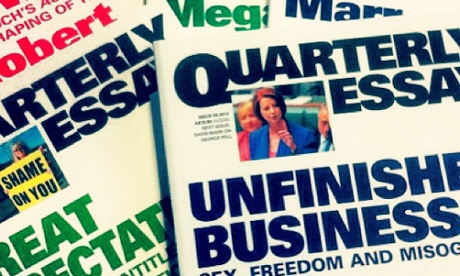
There’s something about a new literary endeavour that suggests tilting at windmills. Longevity can be a harsher measure of success than sales or quality. The journal that achieves all this and political influence to boot is a rare beast indeed, but this month, with the publication of Anna Goldsworthy’s Unfinished Business: Sex, Freedom and Misogyny, Black Inc’s Quarterly Essay reaches its 50th edition since the periodical was launched almost 13 years ago.
The mission statement in the front of the first issue declared its political non-partisanship, its commitment to "truth-telling, style and command of the essay form" and the intention – which has since been borne out to satisfying effect – to carry correspondence to previous essays in the back of each new edition. Launched by Paul Keating, surely nobody ever truly believed in the Quarterly Essay as an organ of impartiality, but that was beyond the point: an independent Australian publisher was taking a chance on the discussion and dissemination of ideas.
There’s a certain poetry to that first issue being about denial and silence. It feels appropriate that it was by Robert Manne. By aiming its attentions right down the barrel of the culture wars and calling out a failure in our dominant cultural narrative, publisher Morry Schwartz and founding editor Peter Craven announced the Quarterly Essay’s arrival with a pugnacious confidence. This was neither News Ltd nor Fairfax; this was not a publication beholden to a university or think-tank: this was political and cultural commentary with literary knobs on.
Here was an essay on Indigenous politics and the stolen generations that straddled sorrowful outrage and forensic condemnation of the prevailing orthodoxy. Craven’s introduction showed ambition and hyperbole in equal measure, quoting TS Eliot to underline its rhetorical flourishes.
Here at last, it declared, was a periodical for those Australians who measured their lives in latte spoons.
Those first few editions felt rich with possibility: John Birmingham on Timor, Guy Rundle on Howard, even, improbably, Don Watson on John Updike, Rabbit Angstrom and Australian/US relations. Eccentricity and literary ambition served the publication well, and each new QE – a naming tradition that’s always made the Essays sound vaguely like a cruise ship – redefined the possibilities for the series. The great ones have been cultural moments in and of themselves, reliably setting off skirmishes and brush fires.
The partnership between Schwartz and Craven was dissolved in a flurry of public indignation and divergent visions (the editor wanted a more international, more cultural outlook; the publisher had a preference for the local and the political). The editorial reins were handed to Chris Feik, the softly-spoken George Clooney of Black Inc: tall, wry, perpetually amused, Feik brought a book editor’s sensibility to the periodical; drawing thoughtful, original work from his authors while remaining less visible than his predecessor.
In its adolescence and into its 20s, as the backlist grew, so too did the QE’s confidence. If some of its youthful swagger and strut had become more muted, in its place came an air of authority. A resolutely left-leaning response to the Howard era, observers might reasonably have expected the precision and urgency of the Essays to diminish somewhat without a conservative government to rail against. The opposite proved to be the case: increasingly it felt as though the QE took as its mission articulating an agenda for a nascent Labour government more comfortable with spin than substance: climate change, sustainability, the Northern Territory intervention.
The 50 back-issues read like a roll call of the past decade plus of Australian political discourse and cultural preoccupations. Reading the late John Button on the challenges and threats facing the Labor party, Gideon Haigh on the cult of the CEO, or Gail Bell on depression, there’s a timelessness to their contributions. Either Australian life simply hasn’t moved on, or these essays (and others) have managed to capture some essential points about our public and intellectual lives.
As far as influence goes, the Quarterly Essay has an impressive track record of profiling political leaders in the period immediately preceding their demise: as well as David Marr’s notorious takedown of Rudd, Annabel Crabb filleted Turnbull, Margaret Simons put the squeeze on Latham, and a cavalcade of editions parsed the Howard legacy before Judith Brett performed the post-mortem. Nothing but a coincidence and historical curiosity, of course, but it’s a marker of the Essays’ influence that the announcement that David Marr was to profile "political animal" Tony Abbott, was met with a frisson of anticipation. What does it say about a publication that we might find it remarkable when it doesn’t bring down an opposition leader?
None of which is to say it’s had a spotless record: eight issues was too long to run before the publication of the first female essayist (Amanda Lohrey on the Greens). With the benefit of time, those essays with an international focus feel like less significant contributions to the conversation than their domestic shelf-mates. But, all said, it’s a remarkably consistent backlist of publications.
A new Quarterly Essay is an event. A 50th Quarterly Essay is an occasion, and a significant one at that. It is, you’ll be unsurprised to hear, erudite, thought-provoking and provocative. It’s also a cracker of a read. Fifty issues in, Morry Schwartz’s vision has become an institution and a tradition.
Grab yourself a copy. There, under the big letter Q in the top left hand corner of the front cover is the promise for issue 51: David Marr on Cardinal George Pell. As ever, the Quarterly Essay gives us a tantalising glimpse of what we’ll all be talking about next. Long may it last.

